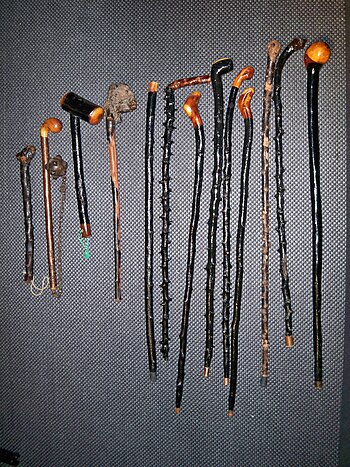Bataireacht: Difference between revisions
Pat Palmer (talk | contribs) (WPAttribution) |
mNo edit summary |
||
| (3 intermediate revisions by one other user not shown) | |||
| Line 1: | Line 1: | ||
{{ | {{subpages}} | ||
{{Image|Assorted shillelagh.JPG|right|350px|Assorted shillelagh.}} | |||
'''Bataireacht''' is a traditional Irish-language term used to describe the various stick fighting martial arts of Ireland. | '''Bataireacht''' is a traditional Irish-language term used to describe the various stick fighting martial arts of Ireland. | ||
| Line 22: | Line 23: | ||
==References== | ==References== | ||
{{reflist}} | {{reflist}}[[Category:Suggestion Bot Tag]] | ||
Latest revision as of 16:01, 16 July 2024
Bataireacht is a traditional Irish-language term used to describe the various stick fighting martial arts of Ireland.
History
The irish have used clubs, alternatively called a bata, bhata, cane, cudgel, or shillelagh, as weapons of civilian self defense for centuries. The art of stick fighting was handed down from fathers to sons and is closely identified with Irish culture to this day. The sticks themselves were not of a standardised size and bataireacht could refer to a four foot long heavy club just as easily as it could a light cane.
In the 19th century bataireacht became associated with Irish gangs called "factions". Beginning first in Munster and Leinster, then spreading to the rest of the country, the Irish faction fights involved large groups of Irish men (and sometimes women) who would engage in huge melees at county fairs, weddings, funerals, or any other convenient gathering. It was a culture of recreational violence[1] which, as time progressed, was vilified as being barbaric.
As the push for Irish independence from the United Kingdom gained steam toward the end of the 19th century, the Irish believed it was necessary to distance themselves from specifically British customs. During this time, bataireacht nearly died out.
Modern practice
A combination of historical and cultural interest has lead to a resurgence of bataireacht in Ireland, the United States of America and Canada. It is also gaining popularity as a form of self defense, since a cane or walking stick can be carried easily in modern society. As is the case with most martial arts, multiple versions exist.
Very few traditional forms of bataireacht survive to this day, though some practitioners can still be found. These traditional styles are specific to the family which carried them through the years and have specific names like "Rince an Bhata Uisce Bheatha" (whiskey stick dance).
Additionally, members of the Western Martial Arts movement have reconstructed styles using a variety of period martial arts manuals, historical newspaper articles, magazines, pictorial evidence and court documents. Surviving instructional manuals which include sections detailing the use of the bata such as those by Allanson-Winn, Percy Longhurst, and Donald Walker tend to be brief.
Few formal schools can be found teaching either traditional or reconstructed bata, but informal study groups are growing in number.
Attribution
- Some content on this page may previously have appeared on Wikipedia.
